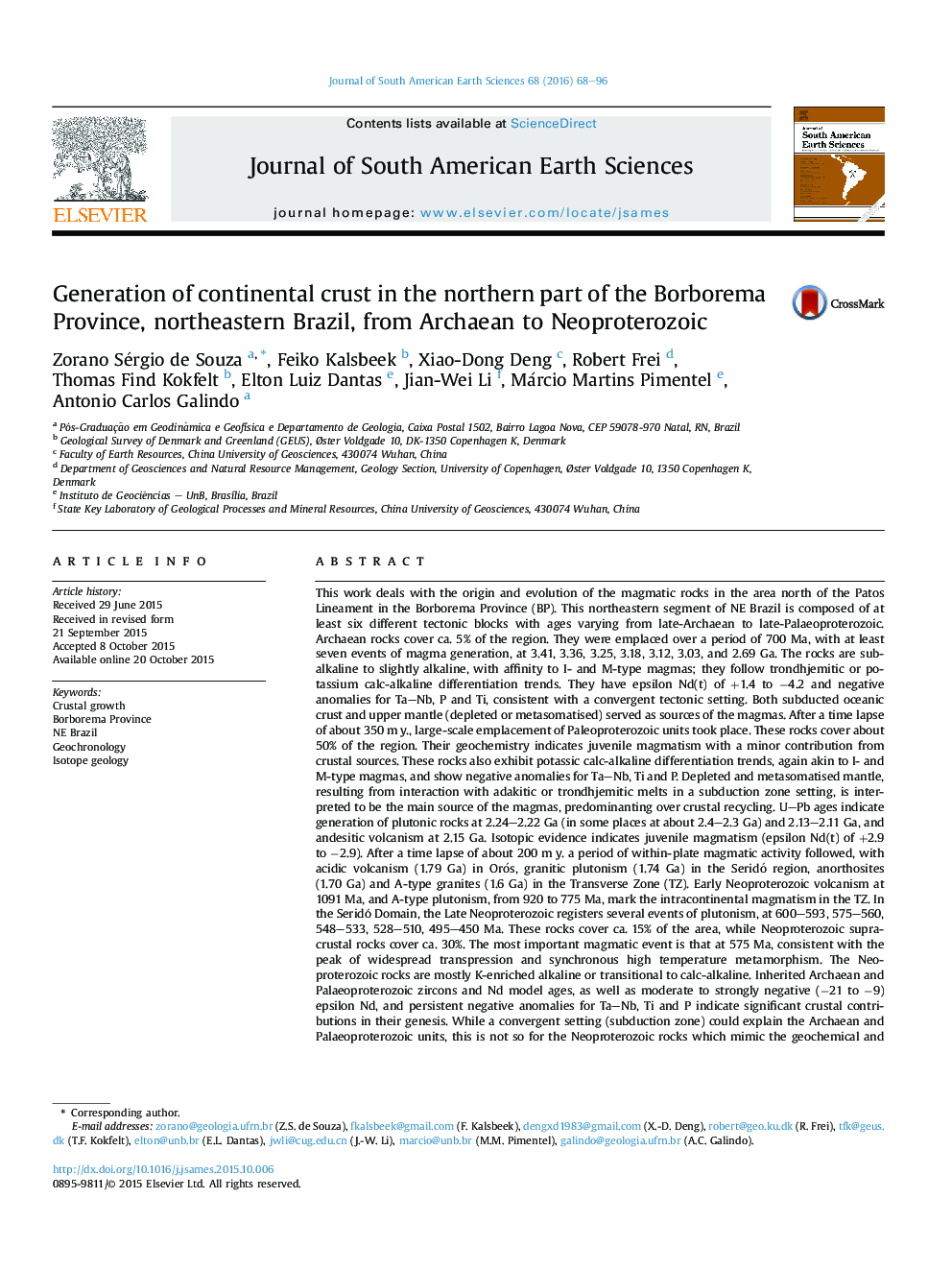| Article ID | Journal | Published Year | Pages | File Type |
|---|---|---|---|---|
| 4682036 | Journal of South American Earth Sciences | 2016 | 29 Pages |
•We report U–Pb ages, WR data and Sr-Nd-Pb isotopes of basement rocks from NE Brazil.•The goal is to understand the mechanisms of continental crust generation.•A subduction setting may explain the Archaean and Palaeoproterozoic units.•This is not so for the Neoproterozoic magmas which are essentially intracontinental.•The Neoproterozoic magmas just mimic the geochemistry of their sources.
This work deals with the origin and evolution of the magmatic rocks in the area north of the Patos Lineament in the Borborema Province (BP). This northeastern segment of NE Brazil is composed of at least six different tectonic blocks with ages varying from late-Archaean to late-Palaeoproterozoic. Archaean rocks cover ca. 5% of the region. They were emplaced over a period of 700 Ma, with at least seven events of magma generation, at 3.41, 3.36, 3.25, 3.18, 3.12, 3.03, and 2.69 Ga. The rocks are subalkaline to slightly alkaline, with affinity to I- and M-type magmas; they follow trondhjemitic or potassium calc-alkaline differentiation trends. They have epsilon Nd(t) of +1.4 to −4.2 and negative anomalies for Ta–Nb, P and Ti, consistent with a convergent tectonic setting. Both subducted oceanic crust and upper mantle (depleted or metasomatised) served as sources of the magmas. After a time lapse of about 350 m y., large-scale emplacement of Paleoproterozoic units took place. These rocks cover about 50% of the region. Their geochemistry indicates juvenile magmatism with a minor contribution from crustal sources. These rocks also exhibit potassic calc-alkaline differentiation trends, again akin to I- and M-type magmas, and show negative anomalies for Ta–Nb, Ti and P. Depleted and metasomatised mantle, resulting from interaction with adakitic or trondhjemitic melts in a subduction zone setting, is interpreted to be the main source of the magmas, predominanting over crustal recycling. U–Pb ages indicate generation of plutonic rocks at 2.24–2.22 Ga (in some places at about 2.4–2.3 Ga) and 2.13–2.11 Ga, and andesitic volcanism at 2.15 Ga. Isotopic evidence indicates juvenile magmatism (epsilon Nd(t) of +2.9 to −2.9). After a time lapse of about 200 m y. a period of within-plate magmatic activity followed, with acidic volcanism (1.79 Ga) in Orós, granitic plutonism (1.74 Ga) in the Seridó region, anorthosites (1.70 Ga) and A-type granites (1.6 Ga) in the Transverse Zone (TZ). Early Neoproterozoic volcanism at 1091 Ma, and A-type plutonism, from 920 to 775 Ma, mark the intracontinental magmatism in the TZ. In the Seridó Domain, the Late Neoproterozoic registers several events of plutonism, at 600–593, 575–560, 548–533, 528–510, 495–450 Ma. These rocks cover ca. 15% of the area, while Neoproterozoic supracrustal rocks cover ca. 30%. The most important magmatic event is that at 575 Ma, consistent with the peak of widespread transpression and synchronous high temperature metamorphism. The Neoproterozoic rocks are mostly K-enriched alkaline or transitional to calc-alkaline. Inherited Archaean and Palaeoproterozoic zircons and Nd model ages, as well as moderate to strongly negative (−21 to −9) epsilon Nd, and persistent negative anomalies for Ta–Nb, Ti and P indicate significant crustal contributions in their genesis. While a convergent setting (subduction zone) could explain the Archaean and Palaeoproterozoic units, this is not so for the Neoproterozoic rocks which mimic the geochemical and isotopic features of the older sources. In the study area, the peak of juvenile accretion (mantle derived magmas) took place in the Archaean (3.4–2.7 Ga) and Palaeproterozoic (2.4–2.11 Ga), whereas crustal recycling predominated in the Neoproterozoic.
